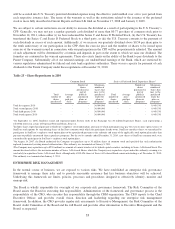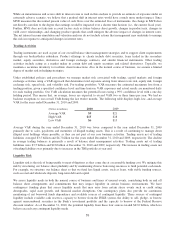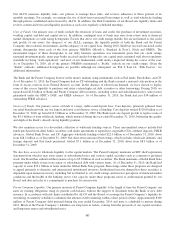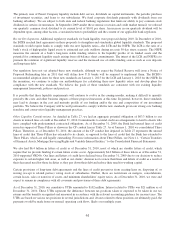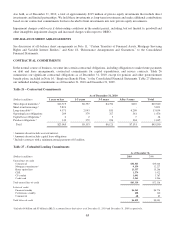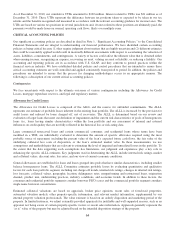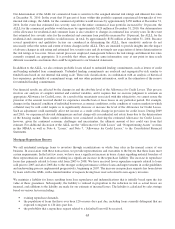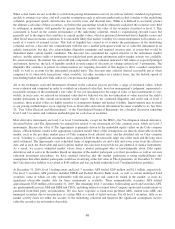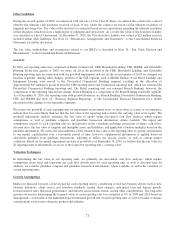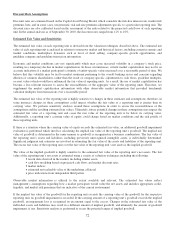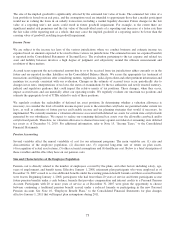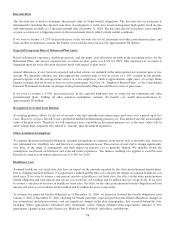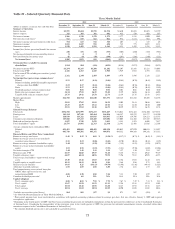SunTrust 2010 Annual Report Download - page 81
Download and view the complete annual report
Please find page 81 of the 2010 SunTrust annual report below. You can navigate through the pages in the report by either clicking on the pages listed below, or by using the keyword search tool below to find specific information within the annual report.
Our determination of the ALLL for commercial loans is sensitive to the assigned internal risk ratings and inherent loss rates
at December 31, 2010. In the event that 10 percent of loans within this portfolio segment experienced downgrades of two
internal risk ratings, the ALLL for the commercial portfolio would increase by approximately $150 million at December 31,
2010. In the event that estimated loss severity rates for the entire commercial loan portfolio increased by 10 percent, the
ALLL for the commercial portfolio would increase by approximately $129 million at December 31, 2010. Our determination
of the allowance for residential and consumer loans is also sensitive to changes in estimated loss severity rates. In the event
that estimated loss severity rates for the residential and consumer loan portfolio increased by 10 percent, the ALLL for the
residential and consumer portfolios would increase, in total, by approximately $154 million at December 31, 2010. Because
several quantitative and qualitative factors are considered in determining the ALLL, these sensitivity analyses do not
necessarily reflect the nature and extent of future changes in the ALLL. They are intended to provide insights into the impact
of adverse changes in risk rating and estimated loss severity rates and do not imply any expectation of future deterioration in
the risk ratings or loss rates. Given current processes employed, management believes the risk ratings and inherent loss rates
currently assigned are appropriate. It is possible that others, given the same information, may at any point in time reach
different reasonable conclusions that could be significant to our financial statements.
In addition to the ALLL, we also estimate probable losses related to unfunded lending commitments, such as letters of credit
and binding unfunded loan commitments. Unfunded lending commitments are analyzed and segregated by risk similar to
funded loans based on our internal risk rating scale. These risk classifications, in combination with an analysis of historical
loss experience, probability of commitment usage, and any other pertinent information, result in the estimation of the reserve
for unfunded lending commitments.
Our financial results are affected by the changes in and the absolute level of the Allowance for Credit Losses. This process
involves our analysis of complex internal and external variables, and it requires that we exercise judgment to estimate an
appropriate Allowance for Credit Losses. As a result of the uncertainty associated with this subjectivity, we cannot assure the
precision of the amount reserved should we experience sizeable loan or lease losses in any particular period. For example,
changes in the financial condition of individual borrowers, economic conditions, or the condition of various markets in which
collateral may be sold could require us to significantly decrease or increase the level of the Allowance for Credit Losses.
Such an adjustment could materially affect net income as a result of the change in provision for credit losses. During 2009
and 2010, we experienced elevated delinquencies and net charge-offs in residential real estate loans due to the deterioration
of the housing market. These market conditions were considered in deriving the estimated Allowance for Credit Losses;
however, given the continued economic challenges and uncertainties, the ultimate amount of loss could vary from that
estimate. For additional discussion of the ALLL see the “Allowance for Credit Losses” and “Nonperforming Assets” sections
in this MD&A as well as Note 6, “Loans,” and Note 7, “Allowance for Credit Losses,” to the Consolidated Financial
Statements.
Mortgage Repurchase Reserve
We sell residential mortgage loans to investors through securitizations or whole loan sales in the normal course of our
business. In association with these transactions, we provide representations and warranties to the buyers that these loans meet
certain requirements. In the last few years, we have seen a significant increase in buyer claims regarding material breaches of
these representations and warranties resulting in a significant increase in the repurchase liability. The increase in repurchase
losses has primarily related to loans sold from 2005 to 2008. We have received fewer repurchase requests related to loans
sold prior to 2005 and after 2008 due to the stronger credit performance of these loans and improvements in credit guidelines
and underwriting process implemented progressively, beginning in 2007. The increase in repurchase requests has been driven
by loans sold to the GSEs, with a limited number of requests having been received related to non-agency investors.
We maintain a liability for losses resulting from loan repurchases and indemnifications that is initially based upon the fair
value of these guarantees. Subsequently, the liability is reduced in proportion to the reduction in risk as actual losses are
incurred, and additions to the liability are made for our estimate of incurred losses. The liability is calculated by sales vintage
based on various factors including:
•existing repurchase demands,
•the population of loans that have ever been 120 or more days past due, including loans currently delinquent that are
expected to migrate to 120 days past due,
•the probability that a repurchase request related to a defaulted loan will be received,
65


